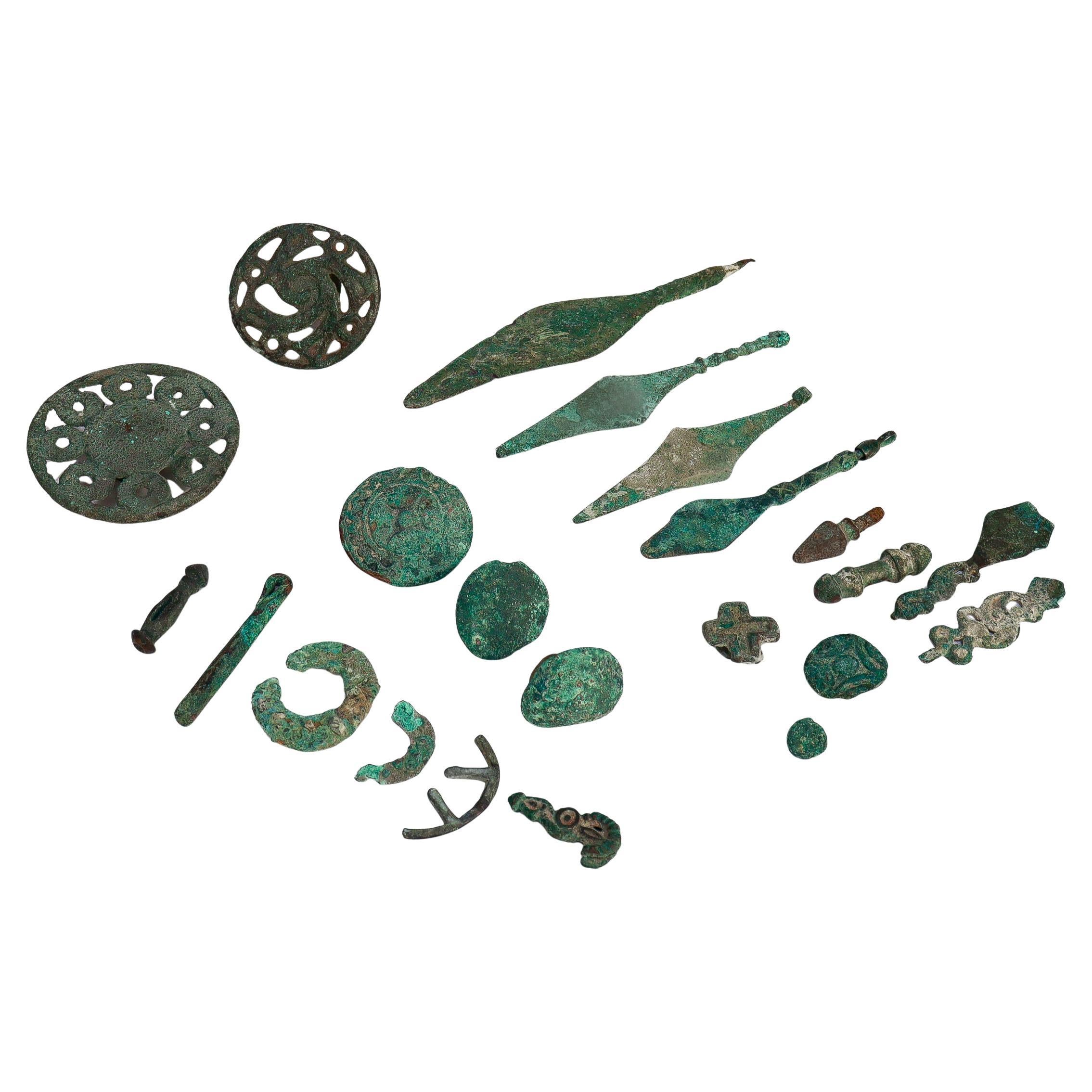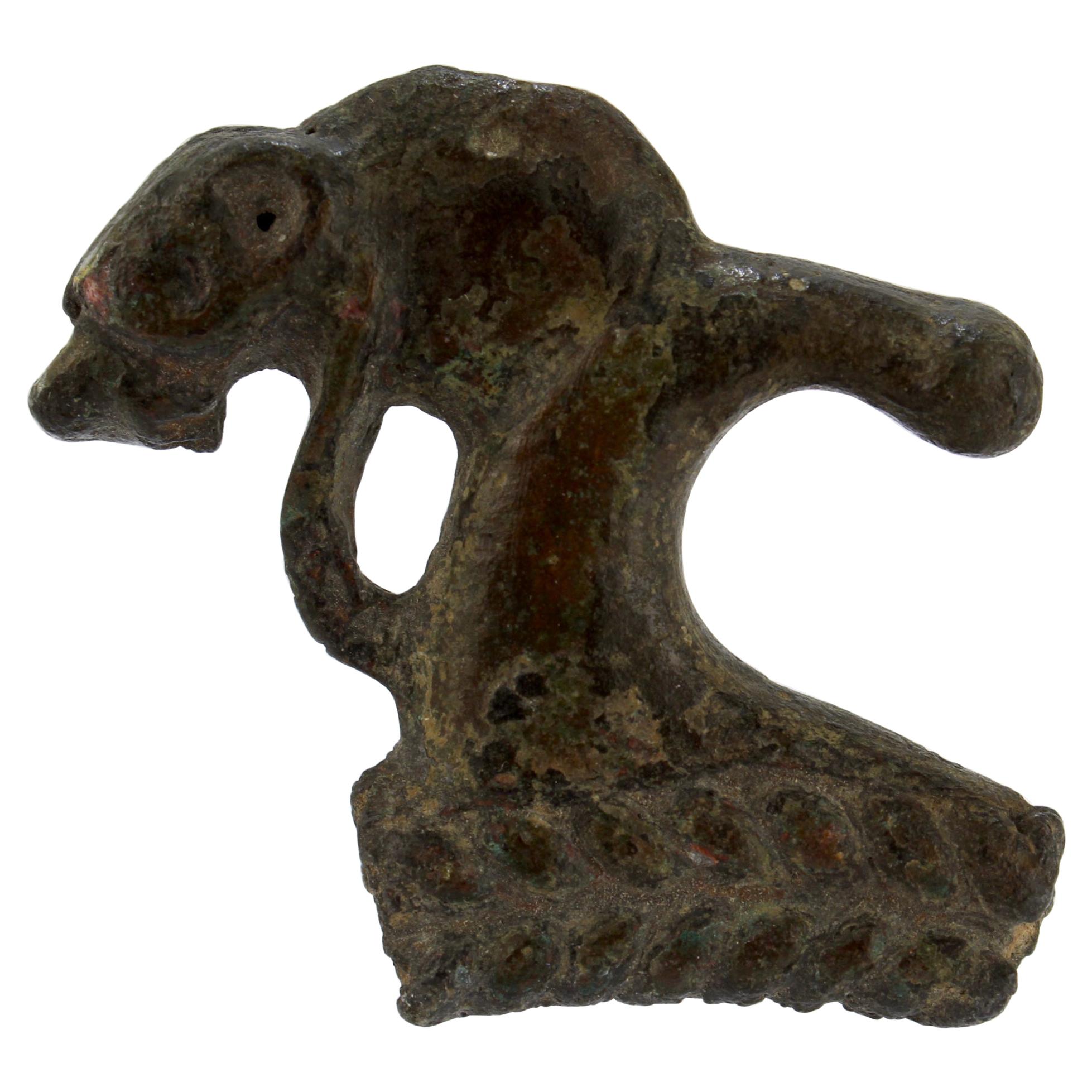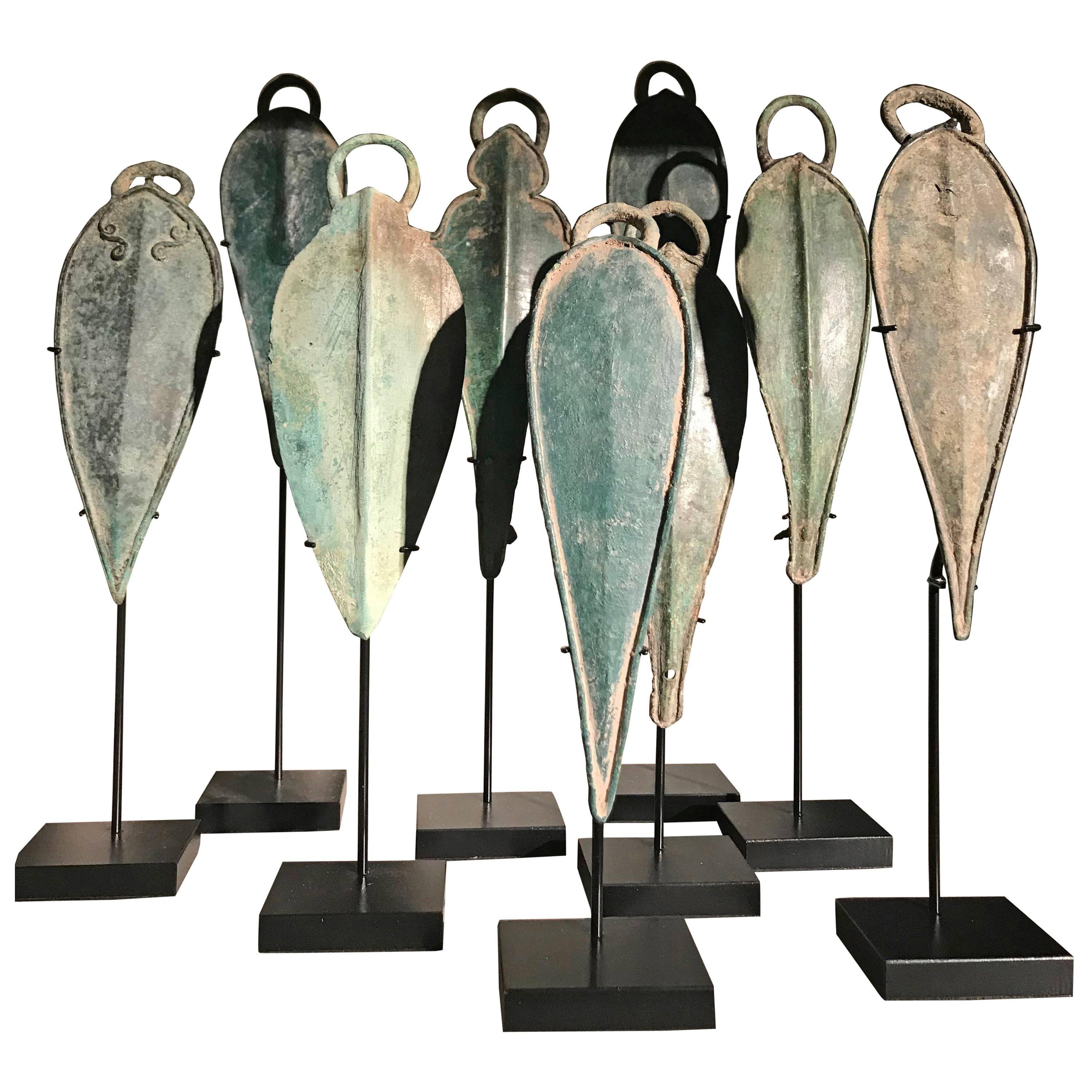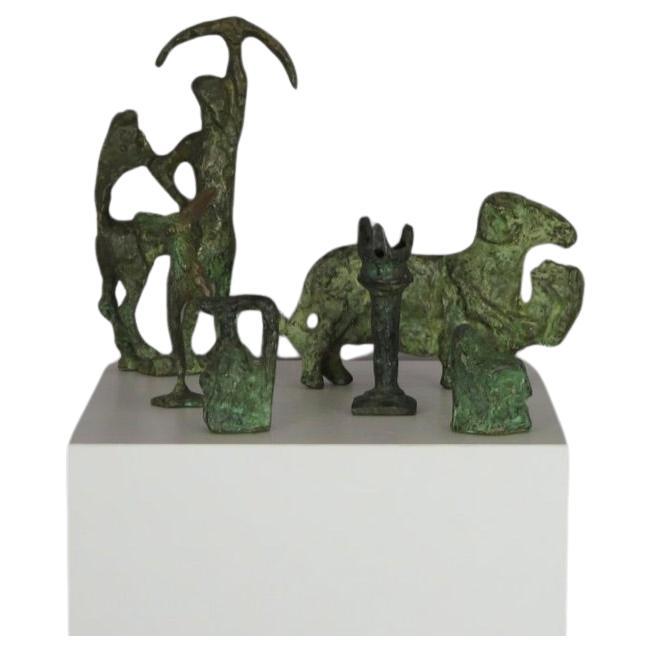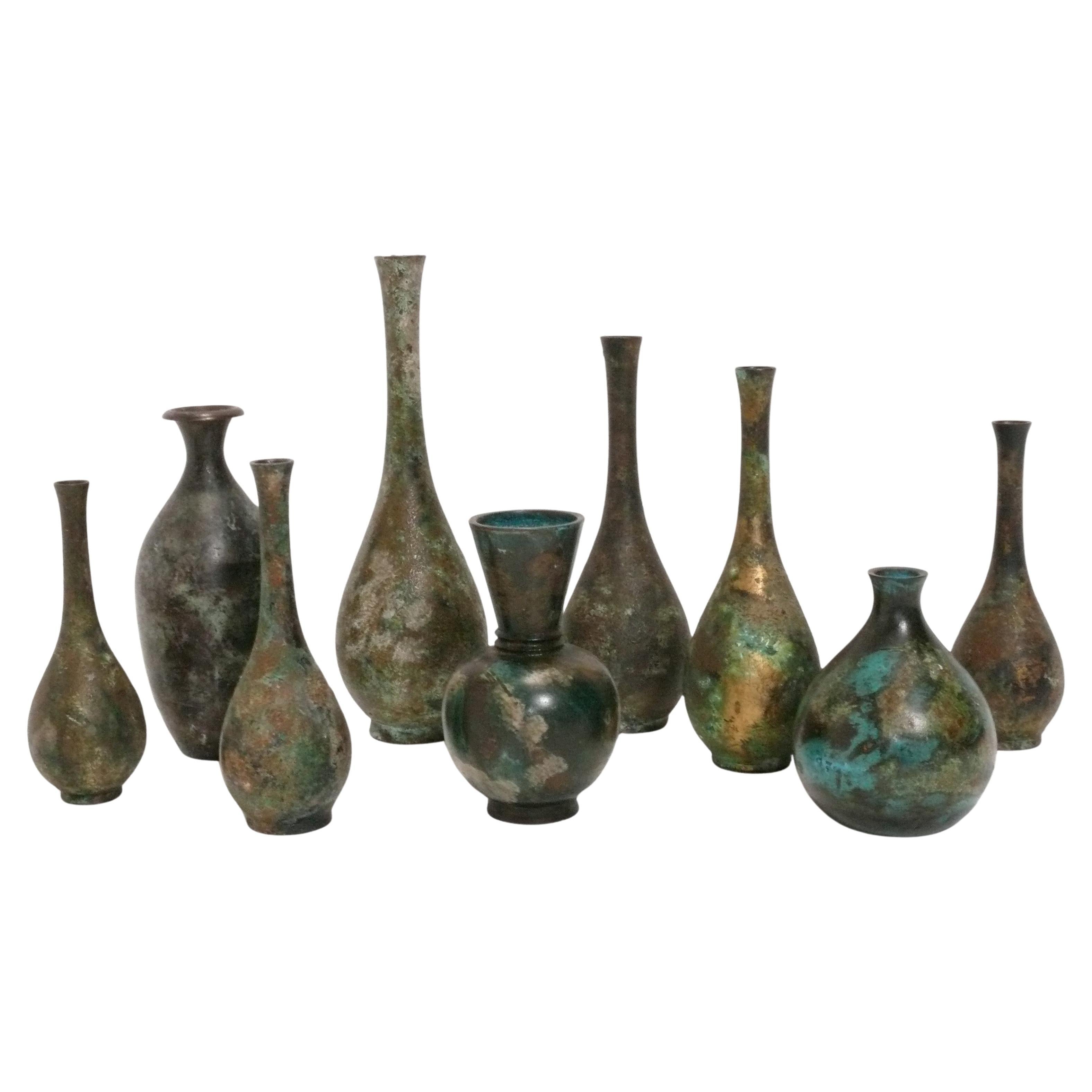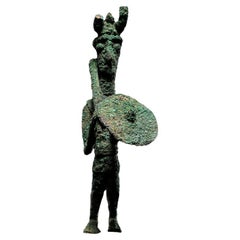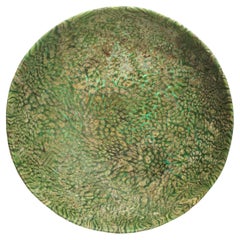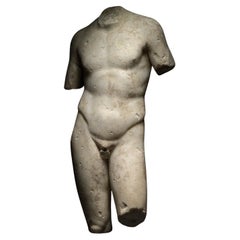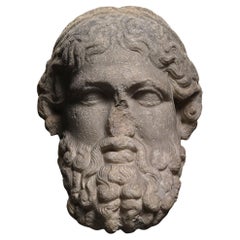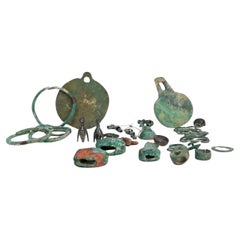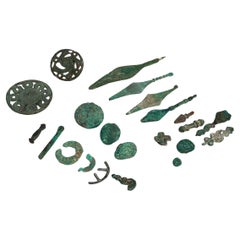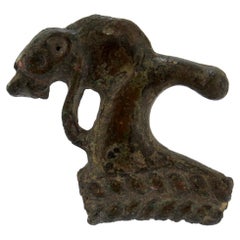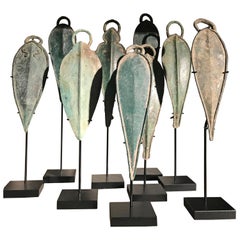Items Similar to Corsican Bronze Hoard
Want more images or videos?
Request additional images or videos from the seller
1 of 8
Corsican Bronze Hoard
$89,276.33per set
£64,800per set
€75,673.83per set
CA$123,609.33per set
A$134,951.80per set
CHF 70,749.71per set
MX$1,639,041.58per set
NOK 883,548.66per set
SEK 834,305.53per set
DKK 564,824.57per set
About the Item
Dagger L: 27.8 cm,
Luniform bronze, possibly a belt buckle L: 10.8 cm,
Shield-shaped bronze with a point Diam: 6.5 cm,
Pommel Diam: 3.7 cm,
Violin-bow brooch L: 17.5 cm,
P-Shaped bow brooch L: 9 cm,
Bow brooch L: 3.5 cm,
Ring 1 Diam: 7.7 cm, Ring 2 Diam: 4.8 cm, Ring 3 Diam: 3.7 cm
A collection of unique bronzes found together on the bed of the Gravona river in the French territorial collectivity of Corsica, during the construction of the Ajaccio-Bastia railway line, which first opened in 1888. This provides two possible precise locations for the find, at the two points where bridges were constructed for the line to cross the river: either in Carbuccia, 10 km north-east of Ajaccio, or at Bocognano, 10 km further in the same direction along the valley. This discovery was published in 1924, in an 8-page essay in the bulletin of the Société Préhistorique Française by Dr Robert Forrer, the director of the Musée préhistorique et gallo-romain in Strasbourg.
Various reasons for the discovery of this group in one place have been suggested. It may have been part of a funerary hoard, or perhaps several burials along the banks of the Gravona, a trader’s wares, or even the hidden treasure of a warrior. Both potential discovery sites are in inland mountainous regions. Forrer posits that the bronzes were brought in from Sardinia, via Ajaccio and up the river, and were the property of a Sherden warrior. However, recent research indicates that the Torrean civilisation in the south of Corsica – previously thought to have begun in the second millennium BCE when Sherden warriors landed on the island – was in fact an indigenous population. There is at least one confirmed example of the distinctive megalithic towers (torri) built by this civilisation in the Gravona valley, north-east of the capital. Therefore, these bronzes may have been produced near the discovery site.
The group contains: a dagger; a luniform bronze that may have been a belt-buckle; a pommel; a disc with a projecting spike, which may have been part of a horses harness or brooch; three bow fibula of various sizes; and three simple rings of differing sizes, possibly a form of proto-currency. The style of these objects suggests a burial date of around 900 BCE.
The dagger is in the style of swords of the late Bronze Age, featuring a leaf-shaped blade with a raised medial rib down its length. The blade and hilt appear to have been cast as one. The hilt joins the blade via a raised semi-circle, and is adorned with five raised round rivets.
The crescent-shaped object features five similar rivets along the arc, and a pointed hook on the reverse. A short cross with rounded ends extends from the inner centre of the arc. The rivets and hook could have served as a means of affixing the bronze in place, suggesting that this object may have been a belt-buckle, or perhaps part of a scabbard or horse harness.
The circular disc features a large rounded spike projecting from its centre, recalling the shields held by warriors in Nuragic bronze statues. Small holes are pierced around the circumference, four of which contain chain links, suggesting that this disc was previously part of a larger object. The disc may have been a phalera on a horse harness or perhaps the centrepiece of a brooch, as in a contemporaneous example in the Metropolitan Museum of Art, New York (2007.498.2).
The pommel takes the form of a hollow ovoid, pierced longitudinally with a hole about 1.3-1.4 cm in dia meter, and with another very small hole through one side. This would allow a stick to be inserted through the pommel and held in place by a small nail, so that the pommel could be wielded as a part of a sceptre or other weapon. However, at only 69 g, it seems most likely that this pommel served a decorative, rather than a martial, function.
This collection contains three brooches, including one of remarkable size. The largest brooch is of the typical violin-bow form, with a long pin and spiral coil. The broad catchplate is adorned with raised points of hammered decoration, with a few horizontal lines incised on the bar connecting the plate to the spiral. The median-sized P-shaped brooch, now missing its pin, features an incised pattern of a cross across the arch. Three thin rings attached in a chain at the foot of the brooch suggest an additional ornament of some kind was originally affixed here. The smallest brooch curves towards a pronounced raised rib in the centre of the bow.
Each of the three rings in this find are formed from a single bronze rod, bent into its circular shape. The largest is made from a cylindrical rod, while the others are each formed from a rhomboid rod. It is unlikely that these would have been bracelets, as their diameters are too small. Forrer proposed that, due to their simple forms and the relationship between each of their weights (the weight of the smallest is about 2/3 of the second smallest, which is approximately 1/4 of the largest), these rings may have been a form of currency, of the kind found in other Bronze Age settlements in Europe.
Published:
R Forrer, ‘Un trésor de bronzes préhistoriques decouvert en Corse’, Bulletin de la Société préhistorique de France, 10, 1924, pp. 224-232.
Provenance:
Discovered c. 1880-90 near Ajaccio, Corsica.
Private Collection of Mr Ducasse.
Thence by descent to Jean Dimitri Ducasse (b. 1883), Sarrebourg.
Thence by descent.
ALR: S00228228, with IADAA Certificate, this item has been checked against the Interpol database.
- Dimensions:Height: 10.95 in (27.8 cm)Width: 4.22 in (10.7 cm)Depth: 1.38 in (3.5 cm)
- Sold As:Set of 10
- Style:Classical Roman (Of the Period)
- Materials and Techniques:
- Place of Origin:
- Period:
- Date of Manufacture:circa 900 B.C
- Condition:Wear consistent with age and use.
- Seller Location:London, GB
- Reference Number:Seller: D41351stDibs: LU5517239202382
About the Seller
5.0
Vetted Professional Seller
Every seller passes strict standards for authenticity and reliability
Established in 1910
1stDibs seller since 2020
- ShippingRetrieving quote...Shipping from: London, United Kingdom
- Return Policy
Authenticity Guarantee
In the unlikely event there’s an issue with an item’s authenticity, contact us within 1 year for a full refund. DetailsMoney-Back Guarantee
If your item is not as described, is damaged in transit, or does not arrive, contact us within 7 days for a full refund. Details24-Hour Cancellation
You have a 24-hour grace period in which to reconsider your purchase, with no questions asked.Vetted Professional Sellers
Our world-class sellers must adhere to strict standards for service and quality, maintaining the integrity of our listings.Price-Match Guarantee
If you find that a seller listed the same item for a lower price elsewhere, we’ll match it.Trusted Global Delivery
Our best-in-class carrier network provides specialized shipping options worldwide, including custom delivery.More From This Seller
View AllA Sardinian Figure of a Warrior
Located in London, GB
An exceptionally rare and important Sardinian bronze figure of a warrior. The highly stylized figure is depicted standing, holding a club resting on his shoulder in the right hand an...
Category
Antique 15th Century and Earlier Italian Antiquities
Materials
Bronze
$188,747
Large Mosaic Glass Dish
Located in London, GB
A shallow glass dish with a composite mosaic pattern formed from polygonal sections of yellow and green canes, set into a translucent green background.
Mosaic glass bowls, dishes, a...
Category
Antique 15th Century and Earlier European Classical Roman Antiquities
Materials
Glass
$33,754
Torso of a Youth
Located in London, GB
A marble statue of a youth in contrapposto position. The torso is idealised but has only softly suggested muscles, giving the impression of youth. The beginnings of the slender arms ...
Category
Antique 15th Century and Earlier European Antiquities
Materials
Marble
$419,244
Marble Head of Hermes
Located in London, GB
Roman head of the god Hermes in an archaising style, following a Greek model from the fourth century B.C.. Hermes is depicted in manner typically found on herms, with a full beard of...
Category
Antique 15th Century and Earlier European Classical Roman Antiquities
Materials
Marble
$70,057
Limestone Statue of Bes
Located in London, GB
A large freestanding statue of the ancient Egyptian god Bes in his canonical form as a stocky dwarf. His face is highly expressive, with large, teardrop-shaped eyebrows drawn into an...
Category
Antique 15th Century and Earlier Egyptian Egyptian Antiquities
Materials
Limestone
$97,129
Portrait Head of Emperor Marcus Aurelius
Located in London, GB
A marble portrait head of the Roman emperor Marcus Aurelius (r. 161-180 A.D.), in his fourth and final portrait type. Known as the Capitoline Imperatori 38 type, after the most famou...
Category
Antique 15th Century and Earlier European Classical Roman Antiquities
Materials
Marble
You May Also Like
Set of Assorted Ancient Gandharan Bronze Jewelry Artifacts
Located in Philadelphia, PA
A fine set of assorted ancient jewelry.
Likely Gandharan in origin.
In verdigris covered bronze.
Comprising 1 beaded necklace, 3 bracelets, 1 signet ring, 2 band rings,, 2 pendants, 4 rams head buckles...
Category
Antique 15th Century and Earlier Indian Antiquities
Materials
Bronze
Set of Assorted Ancient Gandharan Bronze Artifacts / Objects
Located in Philadelphia, PA
A fine set of assorted ancient tools
Likely Gandharan in origin.
In verdigris covered bronze.
Comprising 2 scalpels, 2 razors, 2 razor handles with broken blades, 7 wax seals of ...
Category
Antique 15th Century and Earlier Indian Antiquities
Materials
Bronze
Ancient Roman Bronze Handle or Artifact
Located in Philadelphia, PA
An antique or ancient Roman bronze element.
This piece was an element of a vase or possibly handle to something larger.
It has the head of...
Category
Antique 15th Century and Earlier European Classical Roman Antiquities
Materials
Bronze
Set of Nine Bronze Ornaments, Pectoral Ornaments
Located in Schellebelle, BE
Exceptional Set Of 9 Pectoral Ornaments
South East Asia,Cambodia,11-13th Century
broze material with great oxidation patina
stands with different heights 21/22/23/23/25/27/27/27/30 c...
Category
Antique 15th Century and Earlier Burmese Metalwork
Materials
Bronze
$5,415 / set
Set of Verdigris Bronze Hellenistic Sculptures, Italy
Located in Washington, DC
Set of Beautifully Detailed Bronze Surrealist or Hellenistic Sculptures in the Style of Giacometti. Italy, circa 1930.
Category
Vintage 1930s Italian Hellenistic Figurative Sculptures
Materials
Bronze
Japanese Bronze Vases Collection of Nine
Located in Atlanta, GA
Collection of Nine Japanese Bronze Vases, Japan, at least circa 1950s, some much earlier. The largest vase measures 11"H x 3.5"W. The smallest vase measures 5.25"H x 3"W. They retain...
Category
Vintage 1950s Japanese Japonisme Metalwork
Materials
Bronze
$2,750 / set

